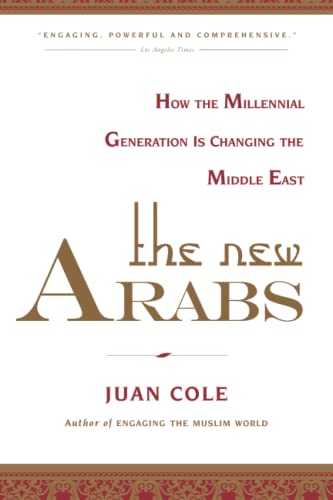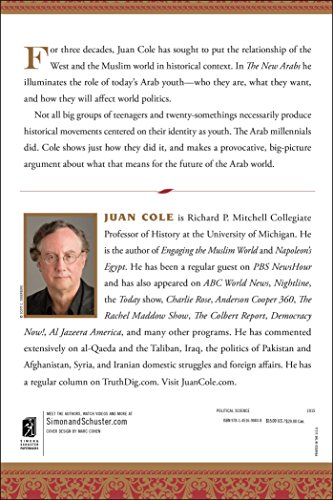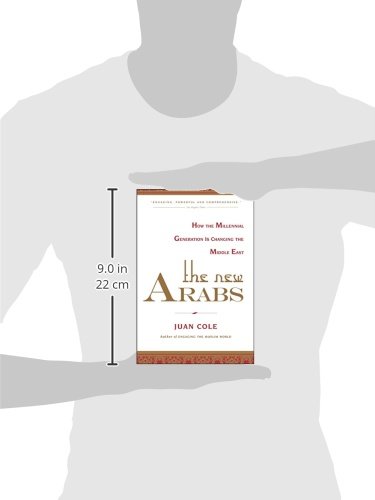Customer Services
Copyright © 2025 Desertcart Holdings Limited
Desert Online General Trading LLC
Dubai, United Arab Emirates




Full description not available
N**A
An exceptional book, compelling in its narrative and analysis; it will teach you a great deal!
“The New Arabs” is a compelling, rich and illuminating book about the Arab revolutions- from the dictatorships that preceded them to the revolutions of 2011 and the post-revolutionary transitions, and the crucial role that the Millennial youth played in them. (The book treats current political developments in Egypt (until December 2013), Tunisia (until January 2014), and Libya (until March 2014).The chronology of the Arab revolutions, as we commonly know it, began in Tunisia. Ben Ali’s Tunisia was corrupt and repressive. Mohammed Bouazizi set himself on fire in protest against the regime, sparking a revolution, which, in January 2011, led to Ben Ali’s overthrow, resulting in fundamental social change in this country on the Mediterranean. The political upheaval in Tunisia then inspired revolutions in Egypt, Libya, Yemen and Syria.This is the shorthand of a much more complex series of events. The story of the Arab revolutions, as delineated in “The New Arabs,” is both longer and more intricate. What began in December 2010 in the Tunisian town of Sidi Bouzid did not take place in a vacuum and was preceded by years of organizing, networking, protests- in which the youth played a monumental role. The organizing began primarily in the 2000s. Young people, as Prof. Juan Cole writes, including courageous individuals like Zouhair and his cousin Amira Yahyaoui in Tunisia, for instance, organized online and in person, confronting a police state and risking imprisonment. At the time, the country faced 20-30 % unemployment among educated youth. Simultaneously, organizing was taking place in Egypt, with the April 6 movement, co-led by Ahmed Maher, emerging as crucial in the 2011 revolution. In Libya, the life of dissident Al Ghazal is emblematic. The Libyan youth was very active in the revolution that began on February 17th .The book details the intricacy of the so-called “sclerotic” police states in Tunisia, Egypt and Libya, the pervasive cronyism (with the presidential families and their acolytes in the lead), the rampant corruption, the increasing repression and lack of opportunities for the young. These abuses help explain why there were textile worker strikes in El Mahalla El Kubra as early as 2008.The vivid, multi-level analysis of the pre-revolutionary societies is only the beginning. Professor Cole’s analysis examines the elaborate network of civil society- movements, parties, organizers, bloggers, which disproportionately emerged from the “millennial” generation, and how they made the revolutions possible. The examination of the 2011 revolutions and the rapid change in Tunisia, Egypt and Libya, is nuanced and persuasive: how the New Left in the region differs from the Left of the 1950s and 1960s; how the dynamics unfolded in urban and rural areas, etc. The Egyptian revolution (as the other two) is treated in its entirety, not merely examining the events in Cairo’s Tahrir square.“The New Arabs’” account of the Libyan revolution is also noteworthy. I followed Libya in the media closely in 2011. Unlike many of these descriptions, Prof. Cole brings the events to life with erudition and clarity. As I read the book, I was astounded at the number of towns where direct action occurred. The chapter on Libya even has details on the revenge expulsion of Tawerghans at one point, and on how and why Benghazi and Tripoli had differing dynamics in 2011.Another of the strengths of the book is the analysis of the post-2011 transitional governments. For example, the explication of the political change in post-Mubarak Egypt is wonderfully elucidating and includes the first parliamentary and presidential elections in that era. Prof. Cole supports his narration by including interviews with activists and delineating the participation of the youth at the ballot box.There is a sophisticated account of how the Morsi era transpired, as well as the role of the youth, the tensions between millions in the population and the government, and the July 2013 takeover of power by the military. The treatment of Egyptian politics continues into December 2013 and includes the arrest of icon activist and blogger Alaa Abd El-Fattah.(The actions of Alaa, in my view, are comparable to those of Solzhenitsyn in the USSR).The account in “The New Arabs” is balanced and not designed to portray details in a rosy light. For example, the 2009 anniversary of the El Mahalla El Kubra strike exposed the limits of youth activism and campaigns. The book makes a case for the Millennials’ tremendous significance- but does so in an honest and equitable way.The discussion of post-revolutionary Tunisia’s transition success and its political party distinctions is illuminating, especially the comparison of the Renaissance party with Islamist parties elsewhere.Given my strong interest in the role of women, the attention to and acknowledgement of the participation of women in the revolutions and in the post-revolutionary era, as well as reference to how policy changes (i.e. new constitutions) would impact women especially appealed to me.The discussion covers Egypt (until December 2013), Tunisia (until January 2014), and Libya (March 2014) in both economic and socio-political terms, and will help you navigate through the barrage of names that have circulated in the political spectrum recently, in the framework of political realities. The conclusion draws parallels among the three cases- making references to revolutions in world history; briefly analyzes Yemen, and draws linkages with other protests in the Middle East and in the West. “The New Arabs” is an exceptional work on the Arab revolutions and the post-revolutionary transitions, which were disproportionately impacted by the countries’ Millennial generation. It is extremely illuminating and written with great clarity.
T**K
Left me thinking
Dr. Cole has deftly navigated these events, providing a detailed subtle analysis of the actors and events. As a seasoned observer of diplomatic and street politics, Dr. Cole places you at the center of the action with the skill of a journalist, while providing valuable historical context. A personal and informative work, this novel delves into the personalities and individual suffering of many courageous martyrs and heroines, leaving the reader to ponder his/her own fortitude in the face of such peril.
N**E
Five Stars
Very well written book on how America should really behave in middle east
A**L
Five Stars
It goes behind the scenes of the last few years in the Middle East and the Arab Spring.
J**D
Good lessons in this book.
Found this book a great help in achieving more understanding of the parts played by the young and the Internet in the toppling of unresponsive governments in the Middle East. There's a lot for us to learn in this work.
J**E
Five Stars
Excellent.
P**S
Juan Cole’s new book about young people in the Arab world
“In his book, Cole looks at youth movements in three of the countries in the center of the Arab Spring—Libya, Tunisia, and Egypt. He examines not only why they rebelled, but also how. He traces the activities primarily of liberal, secular, and daring bloggers in the run-up to, during, and after the revolutions.” http://www.thedailybeast.com/articles/2014/07/01/what-do-arab-millennials-want.html
W**U
Good book if you know nothing about social media
Good book if you know nothing about social media. But, the points could have been made in a more concise manner. Tedious to read.
R**A
http: //www. amazon. ca/gp/product/1451690398?
http://www.amazon.ca/gp/product/1451690398?redirect=true&ref_=cm_cr_ryp_prd_ttl_sol_33
A**S
Now is a good time to learn about the complexity of the Arab ...
Jain Cole is an important writer. Now is a good time to learn about the complexity of the Arab world.
Trustpilot
1 month ago
3 days ago